
Original Link: https://www.anandtech.com/show/2215
Intel Penryn Performance Preview: The Fastest gets Faster
by Anand Lal Shimpi on April 18, 2007 8:00 AM EST- Posted in
- CPUs
You knew it had to be coming. A year ago Intel previewed its first Core 2 processors ahead of their release, and with Penryn due out before the end of the year the boys in blue are back again.
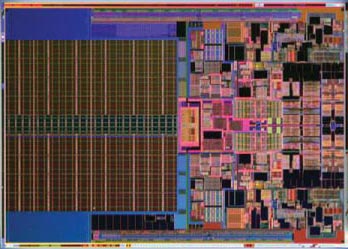
Penryn is still pretty early, although Intel was able to reach over 3GHz on all of the samples we tested. Not surprisingly, the number of benchmarks we were able to run was quite limited. Intel also provided us with a handful of its own test results demonstrated at IDF Beijing which we have reproduced here as well.

Penryn in action
As a recap, Penryn is the 45nm micro-architectural update to Intel's current Core 2 processors. The slide below shows most of the improvements to Penryn:
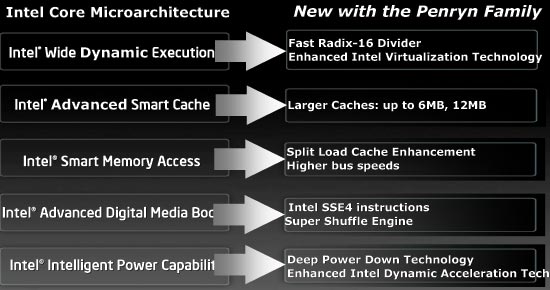
A faster divider and super shuffle engine both improve IPC in very specific applications. As we mentioned in our IDF day 1 coverage, faster FSB speeds appear to be reserved for Penryn based Xeon processors at this point as desktop Penryn cores will use a 1333MHz FSB. Penryn takes the total amount of L2 cache up to 6MB per two cores, giving the quad core Penryn chips a total of 12MB of on-die L2 cache. Penryn also has improved power management technologies, but only for mobile Penryn chips.
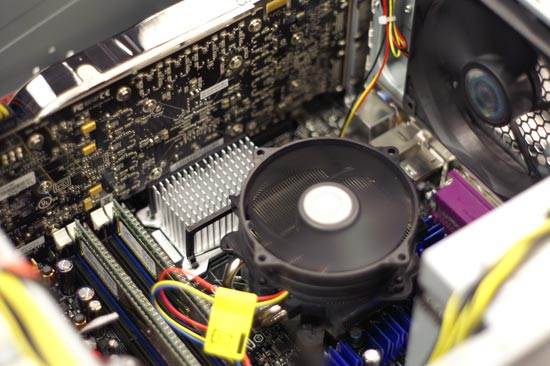
Penryn up and running
The Test
First off we'll start with the results we ran ourselves under Intel's supervision. Intel set up three identical systems, one based on a Core 2 Extreme X6800 (dual core, 2.93GHz/1066MHz FSB), one based on a Wolfdale processor (Penryn, dual core, 3.20GHz/1066MHz FSB) and one based on Yorkfield (Penryn, quad core, 3.33GHz/1333MHz FSB).
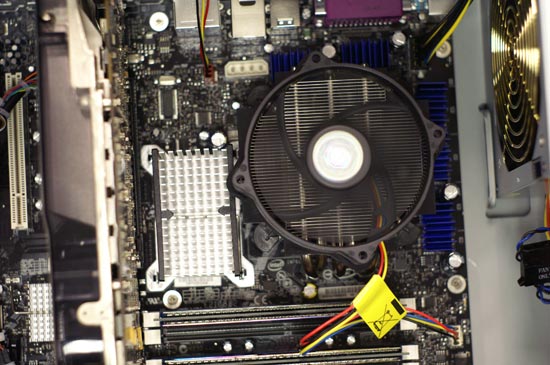
The modified BadAxe 2 board; can you spot the mod?
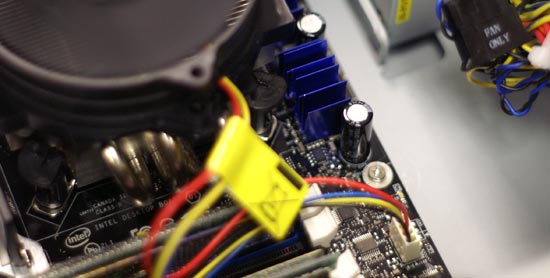
Can't find it? It's under that blue heatsink
The processors were plugged into a modified Intel BadAxe2 motherboard, with the modification being necessary to support Penryn. Each system had 2GB of DDR2-800 memory and a GeForce 8800 GTX. All of our tests were run under Windows XP.
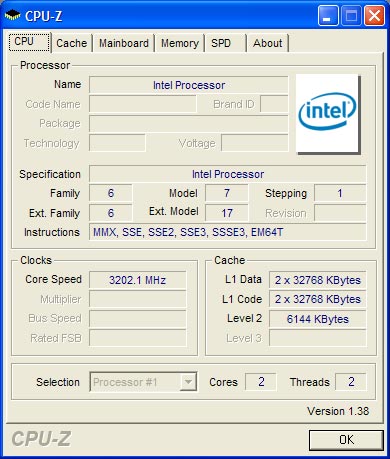
Wolfdale - 2 cores
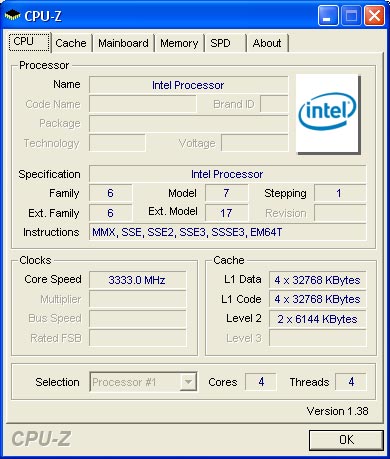
Yorkfield - 4 cores
The Cinebench 9.5 test is the same one we run in our normal CPU reviews, with the dual core Penryn (Wolfdale) scoring about 20% faster than the dual core Conroe. Keep in mind that the Wolfdale core is running at a 9.2% higher clock speed, but even if Cinebench scaled perfectly with clock speed there's still at least a 10% increase in performance due to the micro-architectural improvements found in Penryn.
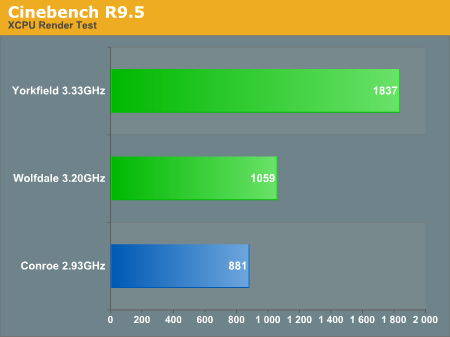
Next up was Intel's Half Life 2 Lost Coast benchmark which was run with the following settings:
| Setting | |
| Model Detail | High |
| Texture Detail | High |
| Shader Detail | High |
| Water Detail | Reflect World |
| Shadow Detail | High |
| Texture Filtering | Trilinear |
| HDR | Full |
Half Life 2 performance at a very CPU bound 1024 x 768 has Wolfdale just under 19% faster than Conroe. Once again, clock speed does play a part here but we'd expect at least a 10% increase in performance just due to the advancements in Penryn.
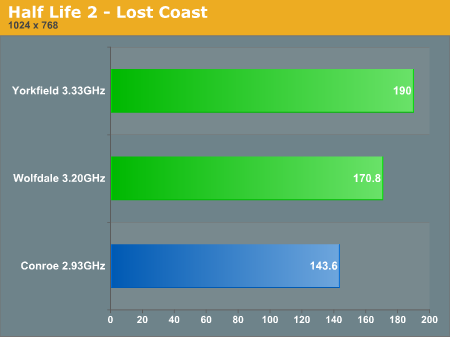
At 1600 x 1200 the performance difference shrinks to 10.6%, still quite respectable:
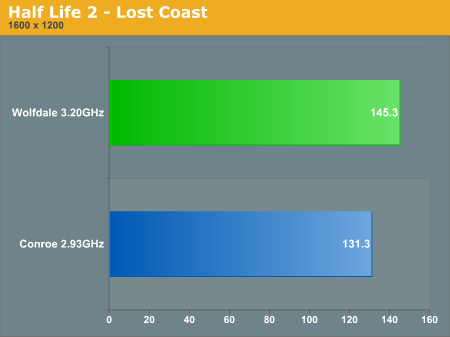
Penryn Performance at 3.33GHz in Beijing
Next up are Intel's Penryn benchmark results revealed at IDF Beijing. The system configuration is a little different, as both Penryn systems run at 3.33GHz and the systems are running Windows Vista Ultimate 32-bit. The exact config is listed below:
| Test System Configuration | Wolfdale 3.33GHz | Yorkfield 3.33GHz | Core 2 Extreme QX6800 (2.93GHz) |
| CPU | Pre-production dual core Penryn 3.33GHz/1333MHz FSB 6MB L2 |
Pre-production quad core Penryn 3.33GHz/1333MHz 12MB L2 |
Core 2 Extreme QX6800 quad core 2.93GHz/1066MHz 8MB L2 |
| Motherboard | Pre-production BadAxe2 975X |
Pre-production BadAxe2 975X |
BadAxe2 975X |
| BIOS | Pre-production BIOS |
Pre-production BIOS |
Pre-production BIOS |
| Chipset Driver |
|
8.1.1.1010 |
8.1.1.1010 |
| Video Card | GeForce 8800 GTX |
||
| Video Driver | NVIDIA 100.65 |
||
| Memory | 2 x 1GB DDR2-800 5-5-5-15 |
||
| Hard Drive | Seagate 7200.10 320GB |
||
And now the results:
| Benchmark | Wolfdale 3.33GHz | Yorkfield 3.33GHz | Core 2 Extreme QX6800 (2.93GHz) |
| 3DMark '06 V1.1.0 Pro CPU (score) : | 3061 |
4957 |
4070 |
| 3DMark '06 V1.1.0 Pro Overall (score) : | 11015 |
11963 |
11123 |
| Mainconcept H.264 Encoder (seconds) : | 119 |
73 |
89 |
| Cinebench R9.5 (CPU test) | 1134 |
1935 |
1549 |
| Cinebench R10 Beta (CPU test) | 7045 |
13068 |
10416 |
| HL2 Lost Coast Build 2707 (fps) : | 210 |
210 |
153 |
| DivX 6.6 Alpha w/ VirtualDub 1.7.1 (seconds) | 22 |
18 |
38 |
For easier comparison we took the two quad-core chips (Yorkfield vs. Kentsfield) and looked at performance scaling between the two:
| Benchmark | Yorkfield Performance Advantage |
| 3DMark '06 V1.1.0 Pro CPU (score) : | 21.8% |
| 3DMark '06 V1.1.0 Pro Overall (score) : | 7.6% |
| Mainconcept H.264 Encoder (seconds) : | 18.0% |
| Cinebench R9.5 (CPU test) | 24.9% |
| Cinebench R10 Beta (CPU test) | 25.5% |
| HL2 Lost Coast Build 2707 (fps) : | 37.3% |
| DivX 6.6 Alpha w/ VirtualDub 1.7.1 (seconds) | 111% |
The Yorkfield system runs at a 13.6% higher clock speed than the Kentsfield system giving it an inherent advantage, but that's clearly not all that's making it faster. Half-Life 2 went up an expected 21.8% (we're assuming that Intel ran these numbers at 1024 x 768), and Cinebench saw a 25% increase in performance.
The DivX 6.6 test is particularly strong for Intel because it is using an early alpha version of DivX with support for SSE4. With SSE4 support, the quad-core Yorkfield processor ends up being more than 50% faster than Kentsfield, which bodes very well for Penryn if applications like DivX can bring SSE4 support in time for launch.
Final Words
Obviously we'll reserve final judgments on Penryn for our official review of the CPU, but these initial results look very promising. We would expect to see clock for clock Penryn vs. Conroe improvements to be in the 5 - 10% range at minimum depending on the application. Factor in higher clock speeds and you can expect our CPU performance charts to shift up by about 20% by the end of this year.
Intel has shown its cards, now it's time for AMD to respond with those long overdue Barcelona tests...







